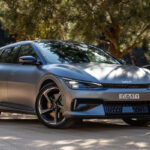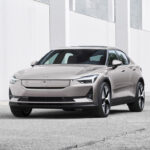
What are the chances of seeing two Polestars on the road at the same time? Not great, or
so we thought, but upon entering the motorway we fell in behind another Polestar 2 on our
way into Sydney.
That’s significant because a brand has to achieve a certain number of sales before a car
achieves visibility on the roads of a city.
The Chinese-owned, Swedish Polestar is an offshoot of Volvo and has been positioned as
a standalone, electric range of performance vehicles.
Polestar 2 is the first and only model to be sold here so far and here we have the recently
updated, top of the range dual motor model.
STYLING
Apart from new wheels and colours and more environmentally friendly production
techniques, there’s the addition of a much-needed screen for the panoramic sunroof to
keep the summer sun out.
Prices start from $63,900 for the standard range single motor.
Long range single motor is priced from $68,400. The top-drawer long range, dual motor
model, with all-wheel drive — is priced from $73,400 (all before onroads).
Metallic paint is standard and all models start with the same basic equipment, with some
minor upgrades for the current model.
Standard stuff includes embossed, textured leather upholstery and two-zone climate air
conditioning.

Driver and front passenger seats are heated and partly power adjustable, with four-way
power lumbar adjustment for the driver — but the seat backs must be adjusted manually.
There’s also 19-inch alloys, LED headlights with active beam, adaptive rear LED lights,
retractable frameless mirrors, auto lights and wipers, auto-dimming rear view mirror, front
and rear park sensors and a foot-operated tailgate.
Few buyers are likely to take the car the way it comes from the manufacturer, with a range
option packs available that build on the basics.
Like the single motor Polestar 2 that we drove a few weeks ago, our current test vehicle
had been fitted with the $3400 Pilot Lite pack, $6000 Plus pack and $6000 ventilated
Nappa leather (ethically sourced of course).
Pilot Lite Pack adds Adaptive Cruise Control and Pilot Assist, auto dimming for side
mirrors plus a further four parking sensors and 360-degree birds eye view.
Plus adds a heated steering wheel, full power seat adjustment, an energy-saving heat
pump, air filtration system, wireless phone charger, 600 watt 13-speaker Harman Kardon
audio plus full-length panoramic glass roof.
Like the car itself, buying a Polestar is a whole new experience too. There are no
dealerships, one orders and pays for the car online. You can however book a test drive, at
a designated ‘space’ in each of the capital cities or at a location of your choosing.
Polestar offers a 5-year five warranty, along with 5 years complimentary servicing and
roadside assistance.
The battery is covered by an 8-year/160,000km warranty.

INFOTAINMENT
Pride of place in the Ikea-inspired cab is occupied by a large Tesla-like 11.2-inch portrait
style touchscreen affixed to the dash.
Polestar 2 is the first car to be fitted with a built-in Google operating system that includes
Google Assistant, Google Maps, with charging options and Google Play Store, which
offers optimised in-car apps for seamless integration.
It’s an Android environment, but iPhone users have not been entirely forgotten, with Apple
CarPlay/Siri.
The system is connected to the net and receives over-the-air updates like a phone.
There are two USB Type-C connections in the front and two more in the rear.
ENGINES / TRANSMISSIONS
The Dual Motor version really cranks performance up a notch or two. Output jumps from
170kW and 330Nm, to a whopping 300kW of power and 660Nm of torque.
Drive is to all four wheels through a single reduction gear transmission.
SAFETY
Polestar 2 gets a full five-star crash rating, with a rear-view camera and seven airbags
including a centre airbag.
There’s also autonomous emergency braking (Car-to-Car, Vulnerable Road User and
Junction Assist) as well as a lane support system with lane keep assist (LKA), lane
departure warning (LDW) and emergency lane keeping (ELK), and an advanced speed
assistance system (SAS).
You don’t get blind spot warning, cross traffic alert with brake support, rear collision
warning and mitigation, nor adaptive cruise control – which are all part of the $3400 Pilot
Lite pack.
DRIVING
With 660Nm of torque on tap the dash from 0-100km/h takes just 4.7 seconds.
One imagines the extra load of a second electric motor, along with the demands of all-
wheel drive would have an impact on the range of the vehicle.
In fact, the dual motor model gets up to 487km, compared to 478km (WLTP) for the single
motor front-wheel drive version.
But the long-range single motor model still pips both of them, with a range of up to 551km.
There’s no key or start button as such, you just put it in Drive (or Reverse), hit the
accelerator and start driving.
But the abrupt way the parking brake disengages as well as the way it surges forward can
be a little unnerving.
Acceleration in this model is rapid but requires a decisive right foot to get going.
Overtaking can be accomplished virtually at will with all that instant torque on tap.
Weighing in at 2113kg, however, there’s a sense of weight when driving the car, as it
bumps and thunks its way over the bad roads and speed humps of suburbia.
This disappears as the car transitions to the billiard table-flat pavement of the motorway.
Although it’s 120kg heavier than the single motor model we drove previously, apart from
the questionable ride quality, the extra power of the two motors more than compensates
for this weight.
Bear in mind, however, the harder you drive the car and the more often you plant the
accelerator, the quicker it will eat through the remaining kilometres.
Regenerative braking recaptures some power when the car is travelling downhill.
You can choose between two levels of regenerative braking via the touchscreen and adopt
a one-pedal style of driving where there’s no need to apply the brakes.
Just lifting off the accelerator brings the car to a halt. It takes some practice and my wife
for one switched it off.
With a 78kWh battery array, 75kWh of which is useable, energy consumption is a claimed
19.4-20.2 kWh/100km (WLTP).
We chalked up 540km at a rate of 21.4 kWh/100km.
Once again, the extra-long seven-metre charging cable is welcome.
For us it means with a bit of maneuvering it is possible to charge the car without having to
move the car in front.
Charging takes as little as 35 minutes using a public, high-powered DC fast charger or
eight hours with a home wallbox (with three-phase power).
No figures are supplied for a standard 10A power point, but we were able to top up a half
empty battery in about 19 hours.
Although no SUV, Polestar 2 sits at a comfortable height for access with a liftback that
rises to reveal a long but shallow luggage area (and hidden area underneath). There’s also
some extra storage in the front boot or frunk as it is known. No provision for a spare tyre.
Instead, a puncture repair kit is provided.
Inside, it’s Swedish and minimalist, with a high-roofed, light airy cabin that has an
upmarket feel. But some of the ergonomics need sorting out.
It’s easy to catch your feet on the control pedals when getting in and out, and the back
seat is cramped, with a low roof line.
And here’s one I didn’t see coming. The deeply recessed front windows are set back a
good 6cm or so.
It was enough to catch my left shoulder on the lip as I was getting out, with painful
consequences.
It’s surprising that in a car as hi-tech as this one, there’s no head-up display — not even of
the pop-up plastic variety.
It’s interesting to note that while Google Maps can keep tabs on the speed limit, it can’t or
won’t provide warnings of school zones and speed cameras.
SUMMING UP
While most buyers will be drawn to the extra performance offered by the dual motor model,
we’d quite happily settle for the long range, single motor version.
At this stage of the transition, it is all about range and charging, and even with one electric
motor still provides a satisfying level of performance.
RATINGS:
Looks: 7.5
Performance: 8.5
Safety: 7.5
Thirst: 7.5
Practicality: 7.5
Comfort: 7
Tech: 8
Value: 7.5
Overall: 7.5
AT A GLANCE
MODEL RANGE
Standard Range (single motor), $63,900
Long Range (single motor), $68,400
Long Range (dual motor), $73,400
Note: These prices do not include government or dealer delivery charges. Contact
Polestar for drive-away prices.
SPECIFICATIONS
(Polestar 2, Long Range Single Motor, fully electric, five-door fastback)
PERFORMANCE:
Battery capacity: 78 kWh
Maximum Power: 300 kW
Maximum Torque: 660 Nm
Fuel Type: Electricity
Plug Type: Mode 2 and Type 1
Charging: Up to 11kW (AC) or 150kW (DC)
Maximum range: 487 km
Energy Use: 19.4-20.2 kWh/100km
CO2 Emissions: 0 g/km
DRIVELINE:
Single-speed reduction gear transmission, single electric motor, all-wheel drive
DIMENSIONS, WEIGHT AND CAPACITIES:
Length: 4606 mm
Wheelbase: 2735 mm
Width: 1859 mm
Height: 1479 mm
Turning Circle: 11.5 metres
Kerb Mass: 2113 kg
BRAKES:
Front: Ventilated disc
Rear: Ventilated disc
STANDARD WARRANTY:
Five years / unlimited kilometres











